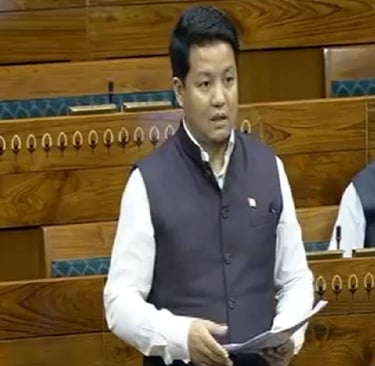Sikkim MP urges increased funding for water conservation and glacial lake flood mitigation
Dr. Subba expressed deep concern over the rapid depletion of natural springs, which are the primary source of drinking water for over 90% of the population in Sikkim.
LOCAL


Lok Sabha MP from Sikkim Dr. Indra Hang Subba urged the central government to allocate more funds for water conservation and mitigation of Glacial Lake Outburst Floods (GLOFs) in the Himalayan region. Speaking during the discussion on the Demands for Grants of the Ministry of Jal Shakti for 2025-26, he highlighted the increasing risks posed by depleting water sources and climate-induced disasters in Sikkim and other Himalayan states.
Dr. Subba expressed deep concern over the rapid depletion of natural springs, which are the primary source of drinking water for over 90% of the population in Sikkim. He pointed out that due to climate change and deforestation, many of these water sources have dried up, affecting thousands of households, especially those in rain-shadow regions.
To address this issue, he called for substantial financial support under the Dhara Vikas Yojana, a state initiative focused on Springshed Development and rejuvenation of drying water sources. He urged the central government to include a special provision under the Jal Jeevan Mission to ensure continuous and sustainable water supply in the Himalayan region, where water scarcity is becoming an alarming issue.
Dr. Subba also drew attention to the increasing threat of Glacial Lake Outburst Floods (GLOFs), which have caused widespread devastation in Sikkim. He specifically criticized the current allocation of Rs 150 crore for Himalayan states, stating that the funds are highly inadequate given the scale of destruction caused by such disasters.
He recalled the devastating flash floods in Sikkim in October 2023, triggered by the outburst of South Lhonak Lake, which led to large-scale destruction of infrastructure, including bridges, roads, and hydropower projects. The floods displaced thousands of people, and several key government and private establishments suffered immense damage.
"The Rs 150 crore allocated for flood management across all Himalayan states is not enough," he said. "GLOF events are becoming more frequent due to climate change, and we need a separate, larger fund dedicated solely to GLOF research, early warning systems, and disaster mitigation."
He demanded that the government increase the financial support significantly, suggesting that the Ministry of Jal Shakti should create a special category for GLOF mitigation under the National Adaptation Fund for Climate Change (NAFCC) to provide long-term solutions for Himalayan states.
Dr. Subba also spoke about the Plastic Waste Management Units in Yuksam and Padamchen, which have been highly successful in tackling plastic waste while generating revenue. He suggested that similar projects should be replicated across the country under the Swachh Bharat Mission, making waste management more sustainable and community-driven.
"These units have proven that effective waste management can be financially viable. If implemented properly, this model can help other states achieve cleaner environments while reducing plastic pollution," he said.
In his speech, Dr. Subba put forward his his urgent appeal for increased budget allocations for water conservation and disaster management in the Himalayan region. He said that without adequate financial resources, it would be impossible to effectively tackle the challenges of water scarcity, spring rejuvenation and GLOF disasters.
"Sikkim has always led in environmental conservation and disaster preparedness, but without adequate financial support from the central government, we cannot continue these efforts on a large scale. It is imperative that more funds are allocated for protecting our springs, securing our water supply, and mitigating glacial lake floods," he said.
He urged the Ministry of Jal Shakti to prioritize Himalayan water security and ensure that policies are tailored to address the unique challenges faced by Sikkim and other mountainous states.
